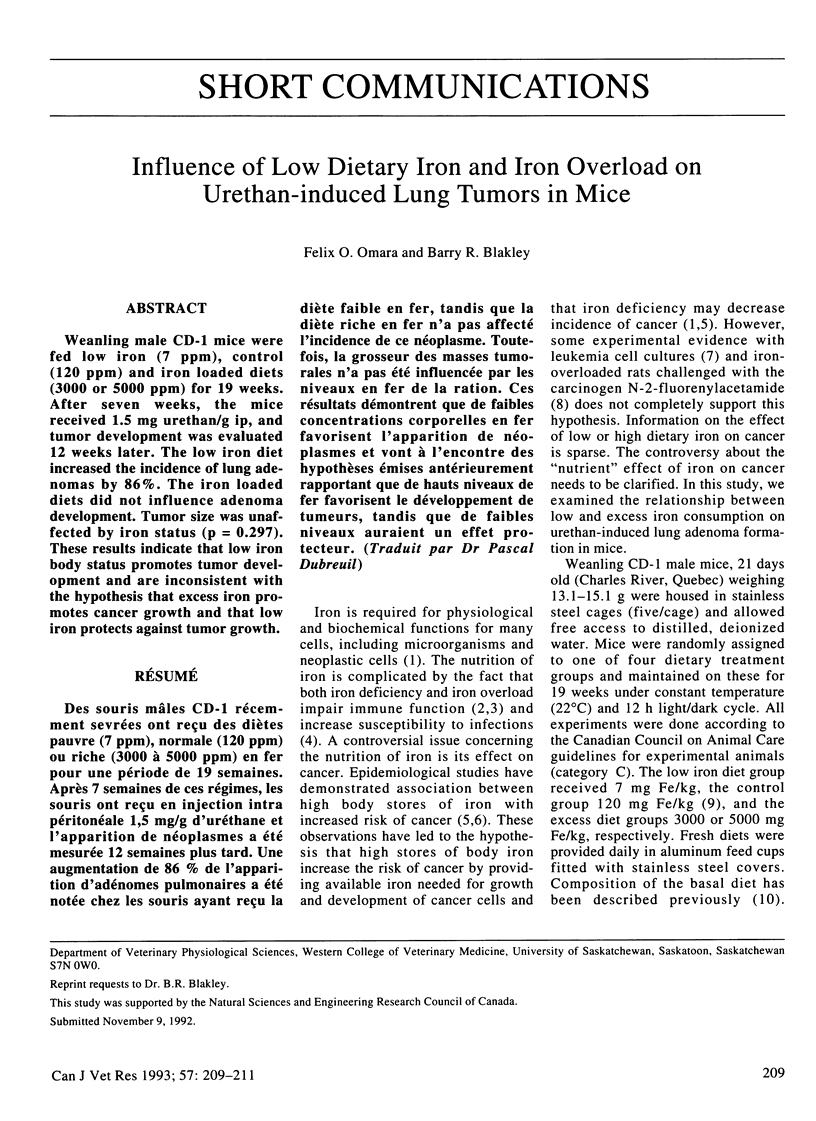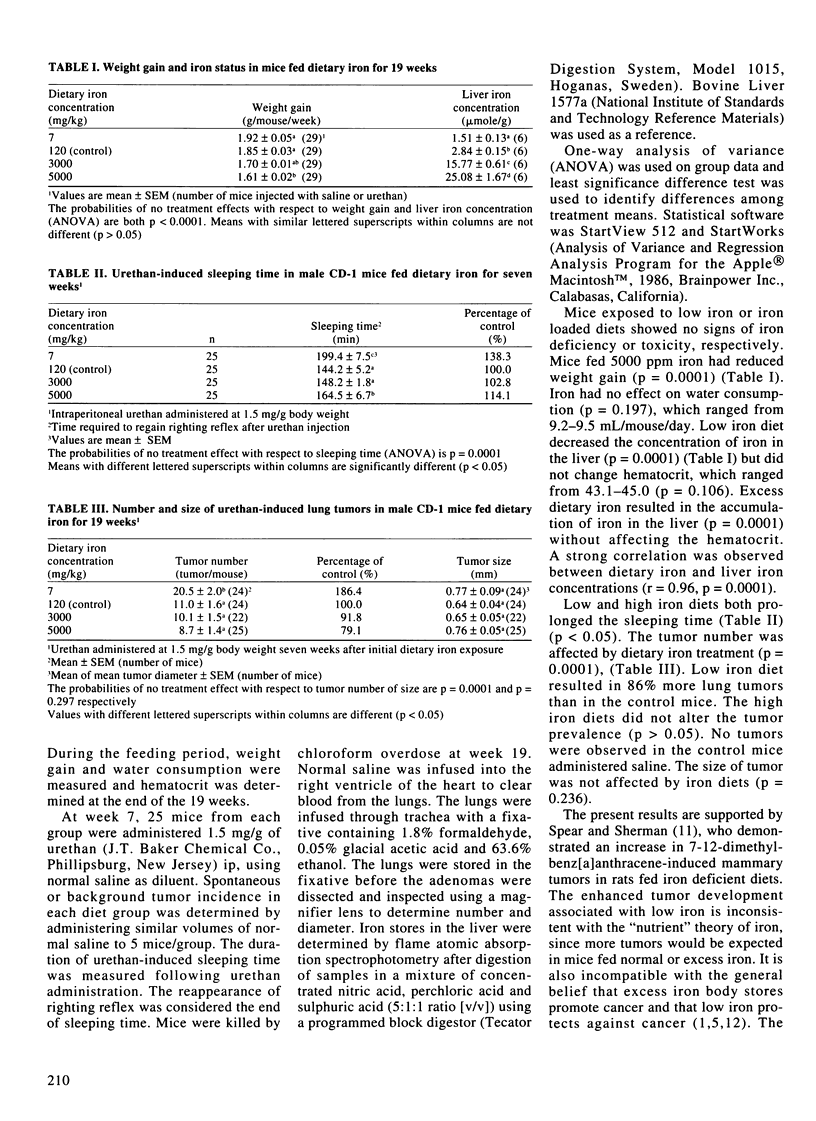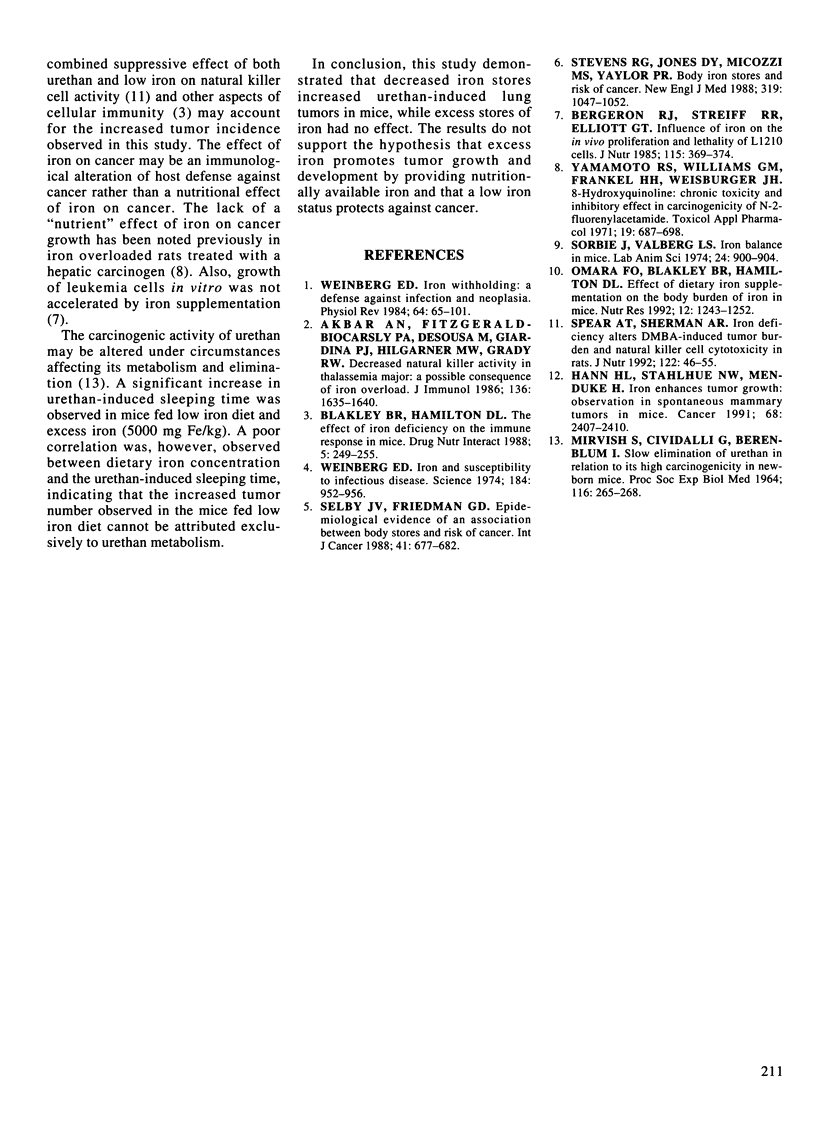Abstract
Weanling male CD-1 mice were fed low iron (7 ppm), control (120 ppm) and iron loaded diets (3000 or 5000 ppm) for 19 weeks. After seven weeks, the mice received 1.5 mg urethan/g ip, and tumor development was evaluated 12 weeks later. The low iron diet increased the incidence of lung adenomas by 86%. The iron loaded diets did not influence adenoma development. Tumor size was unaffected by iron status (p = 0.297). These results indicate that low iron body status promotes tumor development and are inconsistent with the hypothesis that excess iron promotes cancer growth and that low iron protects against tumor growth.
Full text
PDF


Selected References
These references are in PubMed. This may not be the complete list of references from this article.
- Akbar A. N., Fitzgerald-Bocarsly P. A., de Sousa M., Giardina P. J., Hilgartner M. W., Grady R. W. Decreased natural killer activity in thalassemia major: a possible consequence of iron overload. J Immunol. 1986 Mar 1;136(5):1635–1640. [PubMed] [Google Scholar]
- Bergeron R. J., Streiff R. R., Elliott G. T. Influence of iron on in vivo proliferation and lethality of L1210 cells. J Nutr. 1985 Mar;115(3):369–374. doi: 10.1093/jn/115.3.369. [DOI] [PubMed] [Google Scholar]
- Blakley B. R., Hamilton D. L. The effect of iron deficiency on the immune response in mice. Drug Nutr Interact. 1988;5(4):249–255. [PubMed] [Google Scholar]
- Hann H. W., Stahlhut M. W., Menduke H. Iron enhances tumor growth. Observation on spontaneous mammary tumors in mice. Cancer. 1991 Dec 1;68(11):2407–2410. doi: 10.1002/1097-0142(19911201)68:11<2407::aid-cncr2820681113>3.0.co;2-n. [DOI] [PubMed] [Google Scholar]
- MIRVISH S., CIVIDALLI G., BERENBLUM I. SLOW ELIMINATION OF URETHAN IN RELATION TO ITS HIGH CARCINOGENICITY IN NEWBORN MICE. Proc Soc Exp Biol Med. 1964 Jun;116:265–268. doi: 10.3181/00379727-116-29220. [DOI] [PubMed] [Google Scholar]
- Selby J. V., Friedman G. D. Epidemiologic evidence of an association between body iron stores and risk of cancer. Int J Cancer. 1988 May 15;41(5):677–682. doi: 10.1002/ijc.2910410507. [DOI] [PubMed] [Google Scholar]
- Sorbie J., Valberg L. S. Iron balance in the mouse. Lab Anim Sci. 1974 Dec;24(6):900–904. [PubMed] [Google Scholar]
- Spear A. T., Sherman A. R. Iron deficiency alters DMBA-induced tumor burden and natural killer cell cytotoxicity in rats. J Nutr. 1992 Jan;122(1):46–55. doi: 10.1093/jn/122.1.46. [DOI] [PubMed] [Google Scholar]
- Stevens R. G., Jones D. Y., Micozzi M. S., Taylor P. R. Body iron stores and the risk of cancer. N Engl J Med. 1988 Oct 20;319(16):1047–1052. doi: 10.1056/NEJM198810203191603. [DOI] [PubMed] [Google Scholar]
- Weinberg E. D. Iron and susceptibility to infectious disease. Science. 1974 May 31;184(4140):952–956. doi: 10.1126/science.184.4140.952. [DOI] [PubMed] [Google Scholar]
- Weinberg E. D. Iron withholding: a defense against infection and neoplasia. Physiol Rev. 1984 Jan;64(1):65–102. doi: 10.1152/physrev.1984.64.1.65. [DOI] [PubMed] [Google Scholar]
- Yamamoto R. S., Williams G. M., Frankel H. H., Weisburger J. H. 8-hydroxyquinoline: chronic toxicity and inhibitory effect on the carcinogenicity of N-2-fluorenylacetamide. Toxicol Appl Pharmacol. 1971 Aug;19(4):687–698. doi: 10.1016/0041-008x(71)90300-0. [DOI] [PubMed] [Google Scholar]


